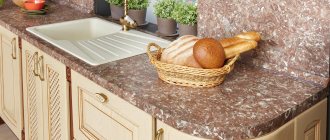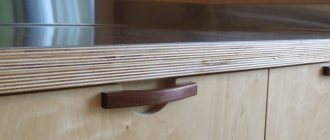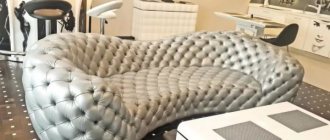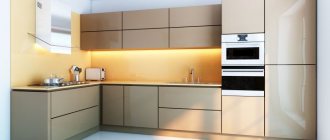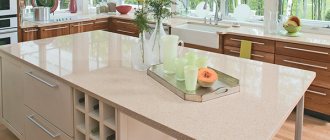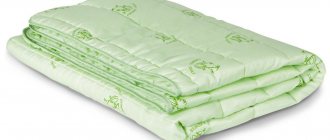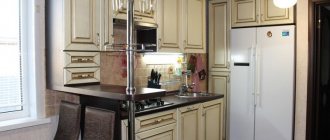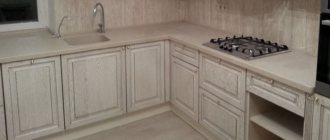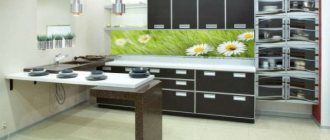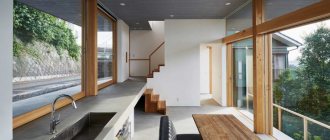Adriatica (Natural Mosaic, China)
Even at the stage of choosing the material, I decided not to make the countertop from laminated chipboard, since it has an unusual shape and in some places it turns out to be quite wide. Artificial stone looks beautiful, but is very expensive, plus you can’t put hot things on it, it’s easy to scratch with a knife. Porcelain stoneware countertops also look good, but they cannot be difficult to cover curved shapes. So I decided to make a mosaic countertop with my own hands. I came across a Chinese mosaic made of natural stone, Adriatica Natural Mosaic. The size of each element is 25x25 mm, so it is convenient for it to form the end of a tabletop 5 cm thick.
How to do it yourself?
To begin with, decide on a specific location area.
Most often, the following options are chosen: a transition between furniture, a mosaic coffee table, and simply a mosaic surface. All tile finishing options are an excellent solution for your interior. It is used to decorate the living room, finish the apron and countertops in the kitchen, but it is not recommended to lay mosaics on an old set. Sometimes, to expand the working area in the kitchen, the window sill is decorated with mosaics.
But the most options for using such tiles can be found in the bathroom. For example, it can be used to disguise a washing machine, decorate walls, or link a washbasin to a screen.
Keep in mind that constructing a tile table requires dexterity and some experience, although it appears to be a routine task. The following materials are excellent for the base: concrete, wood materials with good moisture-resistant impregnation, water-resistant plasterboard surfaces, dense polyurethane.
It is worth noting that you can make a mosaic yourself.
You just need to make fragments of glass that are suitable in shape and color. And glass fragments can be obtained from any company that sells consumables and colored glass for stained glass. This is a great way to try something new and get passionate about it.
To fold the tiled surface you will need:
- grout for seams;
- primer;
- putty;
- antiseptic.
Tools:
- putty knife;
- container for mixing glue;
- container for mixing grout;
- rags;
- sandpaper;
- soft spatula for grouting joints.
To ensure that the mosaic tiles are firmly attached to the table, special adhesive mixtures are used. Experts recommend choosing white plastic mixtures. You can use any adhesive mixtures for tiles, but only when laying opaque mosaics. For glass tiles, you need to choose only transparent or white mixtures.
Surface preparation
Before laying the tiles, it is necessary to level the surface using putty. Next, the surface must be cleaned and degreased. To protect the surface from the appearance of mold and mildew, it is necessary to cover it with antiseptic impregnation. The next step is to apply the primer.
Table with mosaic top
First you need to decide on the basis. A simple coffee table with a square or rectangular top is best. Many people have preserved such tables from Soviet times, and now is the time to update them. To make a mosaic table you will need:
- Mosaic. In this example, 2 types were used: a large one with the effect of Murano glass and a small one of a similar tone. Usually mosaics are sold in grids of a certain size. In this example, a large mosaic grid and 2 fine grids were needed. It is important to pay attention to the thickness of the mosaic - if it is different, then the pattern will be difficult to lay out on the same level.
- Mosaic adhesive can be of the following types: “Moment”, “liquid nails”, special tile adhesive or any other suitable transparent adhesive.
- The grout for the mosaic is selected to match its color; it is advisable to choose a moisture-resistant option.
- Beads are also used in the decoration of the table - they fill the space between two different types of mosaics. Of course, you can grout this place, but it won’t look so nice.
- You will also need sandpaper, a spatula, and alcohol.
- At the first stage, you need to prepare the countertop: wash it, dry it and wipe it with alcohol.
- Then the surface of the table is treated with sandpaper. This part of the work must be done especially carefully to ensure good adhesion of the glue to the surface.
- The mosaic begins to be glued from the outer edge of the tabletop. There is also the option of gluing the central large mosaic after carefully measuring the table top, but this is more complicated, so we will focus on the simpler option.
- It is better if, before starting work, you can lay out the mosaic without gluing it. In this case, you can see in advance the location of the mosaic to create the pattern, and if something happens, change it. After this, they begin gluing the mosaics and beads in the chosen order. It all takes about a day to dry.
- The seams between the mosaics must be grouted with grout, which is diluted according to the instructions (usually to a thick sour cream). Using a spatula, rub all the seams between the mosaics, let the solution dry for 15-20 minutes, and then use the edge of a pencil to make grooves along the seams. You need to wait another 15 minutes, and then remove the excess grout with a damp foam sponge.
- When the grout is completely dry, apply a little vegetable oil to a soft flannel cloth or dry foam rubber sponge and rub the mosaic until shiny.
- After this, you can screw the legs to the tabletop and the table with a mosaic top is ready.
Description of work
- Prepare the wooden surface for decoration. Wipe the table and sand any uneven areas with medium-grit sandpaper. Wipe well again.
- Cut the discs into small pieces, approximately 3x3 cm.
- Glue the disk pieces to the table using glue. Place the elements on the table so that the distance between them is about 2 mm. Do not forget to alternate the back and front sides of the mosaic particles.
- Using construction putty, carefully fill all the empty spaces and indentations created during the design. Wipe off excess substance from the surface with a slightly damp sponge.
- After 12-24 hours, cover the mosaic table with two layers of acrylic varnish (with a break for drying).
https://youtube.com/watch?v=ZGztVvS_WD0
Read further:
How to make a unique ceramic table with your own hands or arrange an entire countertop in the kitchen
How to decoupage a table in Provence style with your own hands
Creative ideas: how to make a table from a cable reel
Garden table
Dishes break for good luck! So why throw away the fragments? Collect them little by little - one day you will make a beautiful thing out of them with your own hands, which will become a reason for a good mood and a witness to your future happiness
A table with a tabletop decorated with a mosaic of porcelain pieces and small ceramic tiles is an ideal solution for the garden. You can put a vase of flowers on it, have a family tea party, and have fun. This colorful ceramic beauty on the table is not afraid of wind, water, and will not fade in the sun.
Italian sink
Anyone familiar with the architecture of Italy has probably paid attention to the beautiful mosaic ensembles in the interiors, where everything is made of mosaics: tables, sofas, flower vases, bath bowls and sinks. Today, anyone can install an Italian sink in their home.
The technology is the same: decorate an old faience sink with mosaic or install a bowl cast from concrete. You can cast it yourself by using two dishes of different diameters instead of a silicone mold.
You will have to lay out the mosaic on the inside of the sink manually, one tile at a time, making sure that the edges of the tiles are in the same plane and do not protrude and do not create roughness. It's a painstaking job, but you'll be rewarded with a luxurious interior.
Tools
- Transparent glue. Needed to give additional strength to the finished mosaic pattern and fix the corners. The glue should be moderately thick to prevent it from spreading over the surface.
- Ruler. A forty-centimeter thick frost is necessary for marking tabletops. The main guiding elements of the drawing are then laid out along these lines. To mark large countertops, you can use a regular tape measure.
- A simple pencil. Needed for drawing marking lines. A soft stylus is best suited for these purposes. It will require frequent sharpening, but will leave clearer marks on the surface.
- Grout for seams. Any company will do. Grouting is necessary to give the mosaic pattern a characteristic feature in the form of obvious seams. The grout also additionally holds the mosaic together, finally turning the pattern into a single whole.
- Rubber spatula. Used to distribute grout evenly over the entire surface. A rubber spatula will not damage mosaic tiles and will not leave scratches.
- Foam sponge. It will help get rid of excess grout and clean the surface of the mosaic panel. You can replace it with a regular rag, but it’s more convenient to work with a sponge.
Step-by-step instruction
- Since the table should turn from beige to white, we first paint the lower part of the table top and legs with white paint. Leave until completely dry.
- Degrease the table surface. Apply glue to it with a spatula, spreading it evenly over the surface. Glue the mosaic. It’s easy to do this with your own hands, since it is already a composition glued onto pieces of mesh.
- To cover the ends, we also glue cut out mosaic strips onto them. The side decor should be secured with tape until completely dry.
- When the glue on the table has dried, we begin to process the seams. Since the object itself is white, we will use white grout. Carefully seal the seams with a rubber spatula. Remove excess grout with a damp sponge. Leave the table for 24 hours to allow the composition to dry.
There is nothing easier than decorating a table in this way with your own hands. Now you can safely put a pot of flowers - water spilled on the surface will not spoil the beautiful tabletop.
Which one is used where?
For the end, shaped tiles are used, which have an L-shape in appearance. With its help, they simultaneously cover the first row and cover the end. The top tile can hang over the end dies, protruding by 2–4 mm.
The ends give the countertop a finished look and increase its aesthetic appeal. You can decorate the top surface of the table in different ways. For example, on a horizontal surface, a die can be laid out in such a way that the edge of the glued fragment hangs over the thickness of the porcelain stoneware. Then the remaining dies are cut into strips and glued at the end edge.
As for laying at an angle of 45 degrees, professionals can do this. The downside of this type of tabletop design is the large amount of trimming, which increases the number of glued fragments. In addition, a professional master can handle this work. Therefore, this design may require labor costs for the tiler.
For the countertop itself, you can use large elements, which will simplify maintenance and also speed up the cladding process, reducing the number of joints. However, if the kitchen is small, then it is preferable to use small tiles. This eliminates the possibility of introducing an imbalance, which can visually reduce the already insufficient square meters of the room.
If possible, the sizes can be increased. By the way, the size can determine the thickness of the dies used, which should not be forgotten before purchasing durable and high-quality material.
As for the use of mosaic for the tabletop, professional tilers can choose it. Even if you want to, working with it requires care and experience, and a beginner will not be able to make all the joints perfectly identical.
Sketch and marking in place
Having decided to make a countertop in the bathroom, they begin to design and mark out the location for its installation.
A mosaic countertop in a bathroom can create a special atmosphere
There are no universal recommendations for designing a countertop, but there are still general principles for its design.
Having decided on the installation location, draw a horizontal line along the bubble level on the wall, at a height of 80 cm from the floor, along which the tabletop will adjoin the wall.
Then, based on the width and length of the future structure, markings are made on the floor underneath it for the locations of the support legs or transverse partitions on which the tabletop will lie.
Labor and cost
One square meter of self-adhesive mosaic costs about 5,000 rubles. The price depends on the supplier and manufacturer. An already sized chipboard panel will cost 100 rubles. Transparent glue within 200 rubles. 250 grams of mosaic grout cost 230 rubles.
Marking the panel and applying mosaics to the surface is a rather painstaking process. Without experience, you can spend three to four hours on this. Subsequent treatment with glue and grout should not cause any particular difficulties and will take a total of about an hour.
Installation rules
Before making a countertop from porcelain tiles, you will need to prepare all the necessary materials and tools. The installation technology of this material is reminiscent of laying tiles. You will need the same adhesive and spatulas. It will be necessary to level the glue with a serrated tool, and with a solid metal spatula to apply the composition to ceramic products and a previously prepared surface.
It is necessary that the seams between the tiles be as small as possible. The optimal seam size would be 1-2 mm, which will prevent the formation of unnecessary gaps.
It is not recommended to use up all the glue at once, since in its finished form it quickly hardens and its beneficial properties are lost. The tiles should be laid on the surface, using a level to check horizontality. You can choose any direction of masonry, as this does not affect the quality of the cladding.
Once the glue has dried, the attached tape can be removed.
To learn how to properly lay a porcelain stoneware countertop, watch the following video.
Reviews of porcelain stoneware countertops are positive, despite the fact that the method of finishing with tiles began to spread not very long ago. Sheet material allows you to reliably hide surface differences. The technology for laying porcelain stoneware presupposes the presence of a wooden base, which must first be carefully measured in order to make all the necessary calculations.
Choosing finishing material
What can you use to cover a tabletop?
As a rule, to cover the countertop, taking into account the specifics of its operation, purchase:
- Tile;
- Mosaic (glass and ceramic);
- Pebbles.
Table top paved with pebbles
These materials have the necessary moisture resistance and are able to resist any external mechanical influence for a long time (provided that during the installation process all the necessary technological requirements were met).
How to choose material
The choice of suitable material can be influenced primarily by the financial capabilities of the family, as well as the taste preferences of its members. In order for the mosaic countertop in the bathroom to be as harmonious as possible, you need to take care of the presence of a frieze with a mosaic structure.
Also, when choosing a material, you need to take into account the convenience of subsequent care.
Here you need to pay attention to the number of seams. The fewer of them there are, the easier it will be for the future housewife to remove all the dirt that appears on the surface.
From this point of view, the preferred option would be a bathroom countertop made of tiles laid using seamless technology.
When choosing a material for finishing a countertop, you can use an interesting technique. Provide inserts in a contrasting color to the main color on the bathroom walls, and then lay out the countertop with material of exactly the same color.
Mosaic table top and frieze
Advantages and disadvantages
Making a mosaic countertop yourself has its disadvantages and advantages.
The advantages are:
- Opportunity to express your creative abilities.
- Saving money on craftsmen and expensive materials.
- Possibility of individualization and full realization of your own fantasies.
Minuses:
- Lack of knowledge and skills to carry out work. The materials may be damaged.
- Miscalculations in size.
- Errors during the manufacturing process.
We make the tabletop ourselves
What you need
In order for the finished countertop in the bathroom to turn out beautiful, in addition to the finishing material, primer for the base and tile adhesive for attaching the mosaic or tile, you must purchase:
- Plywood;
- Glue;
- Waterproof drywall;
- Self-tapping screws;
- Serpyanka ribbon.
A tile bathroom countertop must be mounted on a solid frame, which must be securely attached to the wall. The preferred option would be its location in a special niche, the presence of which should be foreseen at the design stage of future housing.
Tile countertop
Sequence of work
At the very beginning of work, it is necessary to correctly measure the dimensions of the available space and think through the design features of the future product. Based on these data, the required amount of moisture-resistant plywood is determined, which is most often used as the basis for making countertops on your own.
Tabletop composition
The further sequence of actions is as follows:
- After purchasing plywood, two blanks are cut out, which will act as the base. Here you can abandon the traditional rectangular shape, giving preference to non-standard curved lines. When determining the height of the finished product from the floor, one must proceed from ease of use. Often the best option is a height of 0.9 m. You also need to take into account the shape and size of the sink that you plan to install in the future. By choosing a built-in sink, you can avoid additional work aimed at masking drain lines.
- The blanks are connected to each other using glue and self-tapping screws. This ensures sufficient rigidity and strength of the finished structure and, consequently, increases service life.
- A thin layer of tile adhesive is applied to the surface of the countertop and waterproof plasterboard is glued. Self-tapping screws are also used to secure it. Narrow strips of plasterboard are glued to the edges of the future tabletop.
- All existing drywall joints are taped with sickle tape.
- Another layer of tile adhesive is applied to the entire surface of the tabletop and the mosaic or other selected finishing material is glued.
Mosaic laying
- The joints are being grouted.
- After the grout has completely dried, you need to wipe the tiles with a cloth. This will not only remove excess composition, but will also give it a characteristic shine.
- The tabletop is attached to the corners.
- The sink is inserted. To prevent water leakage, the space between the countertop and the sink is filled with sanitary sealant, which, moreover, after final hardening, can prevent accidental movement of the washbasin during its operation.
Not many people decide to make a countertop on their own, because they are initially sure that they do not have a good command of the necessary tools. This does not mean at all that you should abandon your plan. It is enough to independently think through the ideal design for a particular bathroom and turn to professionals.
Finishing technology
The strength and service life of a mosaic countertop depend on a properly prepared surface for finishing. The first step is making the frame. The structure can be made of wooden blocks with a cross-section of at least 50x50 mm or a metal profile. A metal profile is preferable in rooms with high humidity, since the wood can rot. Before starting work, a scale diagram of the frame is drawn on a sheet of paper, and the required amount of material is calculated. After this, ruler marking lines are made on the walls and floor.
Then pieces of timber or profile are cut to the required length. The contours of the frame are secured to the screws on the floor and walls, vertical guides are screwed to them with screws and a rigid connection is made with the upper contour. Gives the desired thickness to the tabletop. If you need a thin tabletop, then the edge of the profile will serve as an edge. The profile is available in various widths: 28x27, 50x40, 65x40, 75x40, 100x40 mm. Select the right size.
The design of the frame can provide shelves or storage spaces. To make curved elements, cuts are made on the sides of the profile in increments of 2-5 cm and bent by hand to the desired radius. Curved elements may require additional stiffeners.
After installing the electrical wiring, sewerage, and water pipes, proceed to the second step - covering the frame. Professionals advise choosing plasterboard with high moisture resistance or DSP. According to the diagram, the cladding parts are cut out and attached to the frame with screws in increments of 10-15 cm; for complex shapes, the fastening increment is smaller. A hole is cut in the plane of the countertop for a sink, stove or communications for supplying gas, water, and electricity.
There may be radial parts in the frame - it is better to make them with arched plasterboard.
Flexible gypsum board is moisture resistant and has a thickness of 6.5 mm. It bends well even in a dry way due to the presence of a fiberglass layer in it. For steep relief lines, the wet method is used: one side of the gypsum board is rolled with a needle roller and moistened until saturated with moisture, preventing the back side from getting wet. On a pre-prepared template, from the most convex part, gradually bend the gypsum plaster strip to the edges, fix it, leave it until dry and then attach it to the desired place.
Arched gypsum board is a thin material. To give strength to the structure, it is laid in two layers. You need to cut parts from the sheet along the long side: the arrangement of fiberglass fibers does not allow bending in the transverse direction. The edges of all joints are cut at an angle of 45 degrees to a depth of 0.5 cm, glued with serpyanka using putty for drywall, primed and puttied to hide defects in the joints, since mosaics require a flat base. The frame is now ready for finishing with mosaic.
The third step is gluing the mosaic. The choice of mosaics is huge.
- Mirror tiles
. Visually enlarge the space and hide unevenness. - Smalt mosaic
is opaque glass, melted under special conditions in a mixture with a persistent pigment. Gives a richness of color refraction. One of the most durable materials. - Venetian glass
is the most expensive and spectacular type of tile. It features a beautiful transition of color and transparency. - Mosaic made of natural stone.
It will add nobility to the finish, but not all types of stone can withstand high humidity in a bathroom or sauna - this information must be obtained from sellers before purchasing. - Porcelain stoneware mosaic
. A win-win option for durability, wear resistance and resistance to various temperatures and moisture. It has a wide range of colors and textures.
The simplest option is pasting with tiled mosaics fixed on mesh, paper or silicone. The tiles are selected according to color, texture and composition already at the industrial production stage - the craftsman only has to glue the finished fragments. The surface is primed, and tile adhesive is applied with a special ridge spatula. Moisture-resistant glue is used; in the presence of a vibration factor, for example, the proximity of the subway, deformable glue is selected.
It is worth considering that transparent tiles will make the adhesive layer visible, so white tile adhesive is selected for glass.
They begin gluing from the front edge of the tabletop, and trim the details at the wall. The end part is finished last: select the appropriate arrangement of tiles at the joint, observing accuracy and thoroughness of gluing - this will be the most visible part, which will be most exposed to impact. All work is carried out using a building level and is constantly checked to ensure that there are no voids under the mosaic tiles.
The fourth step is gluing the baseboard and grouting the seams. Ceramic plinth for tiled mosaic is selected to match the tile. It is also attached with glue. You can do without a plinth if you seal the joint with the wall well with cement mortar. The seams are grouted with a special grouting agent, which comes in various colors. After this, you can install the sink, faucets and connect communications.
DIY mosaic sink decoration
In addition to the mosaic countertop, you can also make a sink designed in the same style. As a source, a ready-made kitchen sink made of stainless steel, cast iron or ceramics is used. With basic construction skills, you can try to make your own sink from concrete or wood.
A mosaic sink looks good in a classic-style bathroom interior
Having the necessary tools at hand, which are not much different from those used in the manufacture of the countertop, you can get to work:
- The surface is prepared: the sink must be dry, clean and grease-free.
- All necessary measurements are taken. It should be taken into account that the sink is not a plane, but has its own bends and a drain hole.
- If the surface is smooth (stainless steel, enamel), then it is better to use epoxy glue, or, using special means or tools, artificially create porosity. In this case, it is allowed to use tile adhesive.
- The cladding begins from the places where the drain holes are located. If necessary, adjust the sizes of the tiles or plates (depending on what is used).
- After each laying, the mosaic must be pressed tightly. Excess glue is removed with a damp cloth. The seams are cleaned with a brush.
- After finishing the cladding, you need to wash the surface well and let it dry.
- After the glue has dried according to the instructions, you should begin grouting the joints.
Despite the fact that a mosaic sink is a very labor-intensive and painstaking task, the result will delight the eye with its beauty and practicality for a long time.
Preparing the base and material for applying decoration
When all the tiles are cut and the resulting elements are sorted by size and color, you can begin gluing the mosaic onto the countertop. For work you will need the following materials and accessories:
For the mosaic you will need: glue, solvent, pliers, sandpaper and a brush.
- latex-based glue;
- spatula for applying adhesive;
- rags;
- paint thinner;
- gloves;
- composition for grouting joints;
- soft spatula for removing grout;
- sandpaper with different grain sizes;
- furniture wax;
- piece of linen.
Before applying the decoration to the table, you need to think carefully about the design. You can draw a sketch of the future image on a sheet of paper, the scale of which will be equal to the tabletop being processed. It is quite problematic to create a complex picture the first time, so experts recommend starting with an abstraction, which can be made from chaotically scattered pieces of tiles.
Before applying the mosaic, you need to decide on a pattern and draw it on the surface of the countertop.
Then you need to treat the countertop. First of all, it is freed from varnish or paint using a solvent. It is enough to cover the wooden surface with a solvent and leave it for a while. The composition will corrode the varnish, which can only be wiped off with a dry cloth.
After removing the varnish, the table is treated with sandpaper. First, coarse abrasive No. 2, 3 is used, and then smaller abrasive No. 1, 0. Processing with sandpaper will make the surface rougher, which will significantly improve the quality of adhesion between mosaic elements and wood or plastic. If the fastening is insufficient, the pieces can easily fall off, which will ruin the entire result of the work.
Examples of interesting solutions
An excellent option is finishing the kitchen with tiles. The tiles are very easy to care for, they are easy to clean, resistant to external factors and look presentable. Let's look at the most interesting design solutions.
For small kitchens, mosaic or small tiles are suitable.
A bright kitchen is a housewife's dream. The tiles can be matched to the walls, in the same tone as the furniture. The walls, countertops, and kitchen facades can all be the same tone.
To cover the walls above the work area, you can use more interesting shades, then the color of the countertop will echo the tone of the apron and you will get a gentle play of color.
When choosing the size and tone of the tiles, do not forget to take into account the size of the kitchen. Light colors will make the kitchen larger, and bright colors will look stylish.
An excellent design solution is to add glass tiles to the interior.
The glass surface will fit perfectly with any design.
There are a great variety of stone and stone imitation tiles on the market; you can also find imitation wood and metal tiles.
Tiles can be not only of different sizes and colors, but also textured or smooth, glossy or mirrored.
When choosing the color of the tiles, do not forget to take into account the level of lighting in the kitchen.
The tile fits perfectly into the Loft style; the tile can be used in any design direction.
Site Map
- home
- DIY master classes and ideas Patchwork, quilting and art quilting
- Let's get dirty
- Applications
- White
- Collars
- Embroidery
- Knitting
- Socks, tights, leggings
- Men's suits
- Drawings and inscriptions
- Lace
- Catching pips
- Slits, cutouts and bindings on clothing
- Buttons
- Invoices
- Scarves
- Hats
- Shorts
- Blouses
- Shirts
- Trousers
- Vests
- Jackets
- Vests
- Swimwear
- Lingerie
- Auto Moto Velo
- Elegantly
- Gloves and mittens
- Sweater or cardigan: DIY alteration
- Shawls
- Belts
- Decor
- Leather
- Wedding dresses and wedding ideas
- Back decor
- Hoodies, sweatshirts and sweatshirts: decor ideas
- Chains
- For children
- Hair ornaments
- For pregnant women: sewing and alteration
- Bloggers
- Persons
- Clothing repair
- Men's ties
- Coat and raincoat
- Changing clothing size
- Materials, techniques and tools
- Transformers
- Help from the audience
- Jeans alteration
- Accessories (not jewelry)
- Creative
- DIY T-shirts
- Jewelry and costume jewelry
- Diy Dresses
- Shoes
- Jacket alterations
- Bags, clutches, suitcases
- Skirts and their alterations
- Simple patterns
- Gadgets
- DIY Halloween and Masquerade, carnival costumes
- Sale of handmade handmade items
- Glasses decor
- Gone with felt
- Ties - bow tie
- Retro patterns
- Brother Innov-is Ie and machine embroidery
- City
- Ecology: in Russia
- Announcements of competitions and lectures
- ads
- Interesting videos
- How to become an author
- Help for orphanages
- Passwords and appearances
- Online shopping
- Have your say
- Want to buy
- Photos (shooting ideas)
- Practical jokes
- Lifehacks
- Urban environment (graffiti, snowmen, etc)
- Sale/exchange of unused items
- Poster. Moscow
- Poster. Saint Petersburg
- Poster. Cities
- Mutual assistance club
- Interior
- Holiday decor
- Kitchen
- Wall decor
- Bedroom
- Bathroom, toilet and mirrors
- Table setting
- Curtains
- Rugs
- Country house
- Furniture
- Lighting
- Pillows
- Organized storage
- Art objects
- Edible decor recipes and ideas
- New Year's interior
- Easter interior
- Valentine's Day - February 14
- Books in the interior
- Flowers, vases and flower pots
- For pets
- Paper and pencils (scrapbooking, origami, etc.)
- Gift wrapping
- Repair
- Fashion
- Street Style
- Star style
- Your style
- Ideas
- Fashion blogs
- Designers
- Fashion history
- Jeans
- To the exit
- Lookbooks
- Hairstyles
- About style
- How to wear?
- Trends
- Nodes
- Makeup/Manicure
- Wedding fashion
- Men's fashion
- Coats and fur coats
- Cinema about fashion
- Review of magazines and photo shoots
- Big sizes
- Details
- Tattoo and piercing
- Must have
- Thing
- Fashionable kids
- With your own hands
- Subculture
- Expensive/cheap
- Jewelry
- Creativity in fashion
- fashion footwear
- How to become a fashion designer
- Fashion and Photo
- Tags
- Alexander McQueen
- alexander wang
- Anthropologie
- ASOS
- Balmain
- Brother Innov-is Ie
- burberry
- celine
- chanel
- Christian Dior
- comme des garçons
- customizing
- dior
- diy
- DIY idea
- Fashion
- fendi
- Free People
- FW 2021-2021
- Givenchy
- Green Fashion
- hand made
- handmade
- harness
- ikea
- inside
- INSYDE
- Jean Paul Gaultier
- Junya Watanabe
- Karl Lagerfeld
- Lanvin
- Lego
- loft
- lookbook
- Louis Vuitton
- Maison Martin Margiela
- Moschino
- must have
- pantone
- Paris
- Pre-Fall 2021
- refashion
- Stella McCartney
- street style
- Streetstyle
- upcycle
- Valentino
- vogue
- zara
- shade
- String bag
- auto and motorcycle
- car moto bicycle
- authorities
- aquarium
- accessory
- accessories
- anatomy
- safety pin
- safety pins
- announcements of competitions and lectures
- antiques
- appliqués
- applique
- watermelon
- art
- art object
- art - objects
- art objects
- art objects
- art object
- art objects
- Art objects
- poster
- poster Moscow
- butterfly
- butterflies
- Grandmothers
- baguette
- ballet shoes
- balcony
- Bandana
- bow
- bow
- bows
- bows
- bar
- Basque
- battery
- fringe
- baseball cap
- white
- linen
- pregnancy
- free patterns
- concrete
- library
- bijouterie
- beads
- blog
- bloggers
- bloggers
- Notepads
- blouse
- blouse
- blouses
- big sizes
- homelessstyle
- borough
- beard
- boho
- barrels
- bracelet
- Bracelets
- keychain
- keychains
- brooches
- brooch
- brooches
- brooch
- trousers
- booth
- future mothers
- letters
- bouquet
- pins
- paper
- paper and scrapbooking
- beads
- Beads
- Beads
- bottles
- puffs
- vase
- vases
- valentine
- wallow
- van Gogh
- bath
- bathroom
- bathroom
- mittens
- your style
- inspiration
- bike
- rope
- outerwear
- ropes
- Branches
- hanger
- hangers
- thing
- video
- second street video
- video from the Second Street project
- business cards
- forks
- vintage
- showcase
- showcases
- air balloons
- Balloons
- felt
- hair
- collar
- collars
- collars
- collar
- second street
- reuse
- veil
- switch
- pattern
- Blouse pattern
- vest pattern
- overalls pattern
- coat pattern
- dress pattern
- sundress pattern
- bag pattern
- T-shirt pattern
- skirt pattern
- patterns
- patterns for children
- retro patterns
- raised patterns on the skin
- high school graduation
- speak out
- exhibition
- darts
- embroidery
- Cross-stitch
- embroidery
- knitting
- Crochet
- gadgets
- nuts
- tie
- the bow tie
- the bow tie
- ties
- pebbles
- Hammock
- garage
- wardrobe
- Harry Potter
- Geometry
- herbarium
- garland
- guitar
- clay
- globe
- tapestry
- hats
- Neck
- city
- urban environment
- peas
- pots
- pot
- ready-made patterns
- gradient
- grunge
- grafitti
- graffiti
- country house
- doors
- door
- decor
- shoe decor
- clothing decor
- glasses decor
- floor decor
- ceiling decor
- Sweater decor
- back decor
- wall decor
- wall decor
- t-shirt decor
- decoupage
- St. Valentine's Day
- Valentine's Day
- Valentine's Day
- money
- tree
- details
- detail
- children
- children's
- children's room
- baby clothes
- baby patterns
- children's hairstyles
- children
- denim
- jeans
- sofa
- design
- Interior Design
- designer
- designers
- for pregnant
- for hair
- for children
- for babies
- for pets
- Doctor Who
- house
- house
- houses
- road signs
- vision board
- drapery
- dremel
- Christmas tree
- Christmas decorations
- jacket
- jackets
- pearl
- animals
- vest
- fence
- hairpins
- soiled clothes
- patches
- Clasp
- fastener - zipper
- zipper
- zipper
- star Wars
- star style
- stars
- Animal competition
- mirrors
- mirror
- icons
- umbrella
- umbrella
- Pincushion
- pincushions
- Game of Thrones
- toys
- ideas
- business ideas
- business ideas
- ideas for inspiration
- wedding ideas
- photo ideas
- Halloween Ideas
- gift ideas
- photo ideas
- idea
- gift idea
- photo idea
- from bottles
- from ties
- from toys
- from books
- from boxes
- from the trash
- from pallets
- from scarves
- from dishes
- from belts
- from napkins
- from old
- from pipes
- headboard
- mockery of the logo
- change of size
- ikea
- tools
- interesting videos
- interior
- art
- fashion history
- how to wear
- how to become an author
- how to become a designer
- how to become a fashion designer
- how to become a fashion designer
- how to become a fashion designer
- cacti
- calendar
- gate
- fireplace
- stones
- hood
- pencils
- quarantine
- cardigan
- Karl Lagerfeld
- Pockets
- carnival costumes
- carnival costume
- map
- World map
- painting
- paintings
- cardboard
- cards
- customization
- car customization
- cafe
- cuffs
- swing
- flowerpot
- quilt
- sneakers
- cape
- ceramics
- bricks
- brushes
- Tassels
- clutch
- clutches
- rivets
- cell
- flower bed
- keys
- Housekeeper
- coolness
- books
- Books in the interior
- Books and magazines
- carpet
- forging
- rug
- rug skin
- rugs
- carpets
- leather
- tights
- collage
- collections
- collection
- necklace
- rings
- ring
- stroller
- overalls
- teenager's room
- dresser
- cans
- basket
- Basket
- baskets
- feeder
- boxes
- crown
- coronavirus
- corset
- pigtail
- braids
- braids for adults
- braids for children
- cosmetics
- costume
- leather jacket
- braids
- cats
- Coffee
- wallet
- wallets
- cats
- dye
- creative
- creativity in fashion
- creative crafts
- creative patterns
- armchair
- bed
- cut
- sneakers
- lace
- wings
- caps
- fublya doll
- dolls
- pendant
- swimsuit
- swimwear
- jacket
- jackets
- jacket alterations
- kitchen
- bench
- life hack
- life hacks
- lamp
- landscape design
- leggings
- leggings socks tights
- easy to sew
- easy to sew
- labels
- lectures
- Lecture
- ribbon
- ribbons
- ladder
- summer patterns
- summer fashion
- Summer clothes
- personal experience
- dream Catcher
- catching pips
- spoons
- patchwork technique
- patchwork
- loft
- lookbook
- lookbooks
- chandelier
- shop
- Mike
- makeup
- makeup and manicure
- macrame
- kids
- kids
- Brazier
- dummy
- cuffs
- manicure
- shirtfront
- Mann Ivanov and Ferber
- marketing
- mask
- fancy dresses
- fancy dress
- Master Class
- Master Class
- Master Class
- master class *Lena*
- workshop
- materials
- materials and techniques
- materials tools and techniques
- materials tools and techniques
- equipment materials and tools
- machine embroidery
- furniture
- furniture from nothing
- DIY furniture
- medical mask
- copper pipes
- metal
- tattooing method
- metro
- fur
- mecherdising
- miniature
- Miniatures
- minimalism
- Mitts
- MYTH
- multi-layering
- fashion
- fashion and photography
- metro fashion
- fashion designer
- fashion footwear
- fashion bloggers
- fashionable kids
- fashionable jeans
- mosaic
- lightning
- lightning
- coins
- sea
- Ice cream
- marine interior
- Moscow
- motorcycle and auto
- men's fashion
- men's ties
- Men's shirts
- men's suit
- musical instruments
- floss
- dummy method
- garbage
- Stuffed Toys
- to the exit
- inscriptions
- cape
- smartly
- insects
- Headphones
- stripes
- do not shoot
- invisible
- Unusual
- unusual braids
- underwear
- threads
- new year ideas
- New Year's decor
- New Year's interior
- New Year
- scissors
- socks
- socks tights leggings
- about style
- magazine review
- book review
- bezel
- Wallpaper
- frill
- image
- education
- shoes
- DIY shoes
- ads
- cloth
- blanket
- necklace
- window
- window
- optical illusions
- organizer
- organized storage
- organized storage
- origami
- lighting
- autumn
- postcard
- postcards
- office
- glasses
- sequins
- pallets
- sticks
- pallets
- coat
- coat and raincoat
- coats and fur coats
- memo
- punk
- panel
- passwords and appearances
- Easter
- Easter interior
- getting dirty
- alteration
- car modification
- alteration of linen
- blouse alteration
- alteration of trousers
- bra alteration
- bike conversion
- alteration of a turtleneck
- alteration of jeans
- jeans alteration
- denim alteration
- alteration of the jacket
- alteration of the vest
- cardigan makeover
- Alteration of sneakers
- alteration of the clutch
- alteration of tights
- Jumpsuit alteration
- Dresser remodel
- alteration of the sweater
- swimsuit alteration
- alteration of the jacket
- leggings makeover
- T-shirt alteration
- furniture remodeling
- alteration of a men's suit
- alteration of socks
- shoe alteration
- alteration of clothes
- alteration of the jersey
- remaking glasses
- coat alteration
- alteration of coat and jacket
- alteration of coat and raincoat
- alteration of gloves
- alteration of the jacket
- dress alteration
- alteration of dresses and skirts
- alteration of the cloak
- alteration of belts
- belt modification
- alteration of shirts
- shirt alteration
- backpack alteration
- alteration of boots
- sweater alteration
- sweatshirt alteration
- chair remodel
- bag alteration
- alteration of bags
- alteration of the vest
- Tishotka remake
- alteration of sweatshirts
- alteration of the top
- bedside table remodel
- T-shirt alteration
- alteration of t-shirts
- alteration of hoodie
- suitcase conversion
- alteration of scarf
- Remake spanking
- hat alteration
- alteration of shorts
- alteration of shorts
- alteration of a fur coat
- skirt alteration
- alterations
- alterations for children
- clothing recycling
- a person
- gloves
- gloves and mittens
- feathers
- loops
- patchwork
- Cookie
- Stove
- Piano
- blazer
- picnic
- pets
- Pizza
- scarves
- handkerchief
- dress
- DIY dress
- DIY dress
- dresses
- Diy dresses
- cloak
- plaid
- weaving
- shoulders
- hangers
- Tile
- beach
- beach fashion
- Beachwear
- Beach bag
- beach patterns
- present
- DIY gifts
- handmade gift
- selection
- pallets
- crafts made from natural materials
- crafts with kids
- candlestick
- Candlesticks
- suspender
- Pillow
- pillows
- cover
- tires
- online shopping
- floor
- useful for the new year
- polymer clay
- Shelf
- shelves
- strip
- stripes
- help from the audience
- Pompon
- pompoms
- poncho
- purse
- portfolio
- Order
- bed sheets
- dishes
- ceiling
- belt
- holiday decor
- festive interior
- offer
- An offer of marriage
- prints
- hallway
- hairstyles
- hairstyles for children
- hairstyles and braids
- hairstyle
- clothespins
- cork
- traffic jams
- wires
- wire
- sale
- promotion
- transparency
- slots
- simple pattern
- simple patterns
- I'm asking for advice
- birds
- Birds
- Bird theme
- buttons
- buttons
- down jacket
- patchwork
- hoop
- workplace
- Sink
- shells
- frame
- frames
- plants
- wood carving
- belt
- belts
- repair
- furniture repair
- Shoe repair
- Clothing repair
- retro
- retro patterns
- recipe
- recipes
- drawings
- drawings and inscriptions
- drawings and inscriptions
- drawing
- draw
- practical jokes
- painting
- shirt
- shirts
- sleeve
- sleeves
- needlework
- handmade
- backpack
- DIY backpack
- backpacks
- ruffles
- garden
- napkins
- boots
- sundress
- Sashiko
- wedding fashion
- Wedding Dress
- wedding ideas
- wedding
- welding
- lamp
- lamps
- Candles
- sweater
- Sweatshirt
- with your own hands
- do it yourself
- table setting
- hearts
- heart
- silver
- Earrings
- earrings
- Tablecloth
- birdhouse
- birdhouses
- Skateboard
- skeleton
- skeletons
- scotch
- scrapbooking
- complex patterns
- complex cut
- snowman
- snowmen
- snowflakes
- modern handicraft
- Owls
- bedroom
- sport
- sportswear
- old ladies
- articles
- glass
- bugles
- wall
- style
- celebrity style
- table
- cutlery
- rhinestones
- Arrows
- construction
- chair
- chairs
- stitch
- subculture
- succulents
- bag
- DIY bag
- bags
- DIY bags
- bags and luggage
- DIY bags
- superheroes
- scheme
- surprise
- Cache
- taxidermy
- Tardis
- dishes
- tattoo
- tattoo and piercing
- creation
- new topic tags
- new topic tags (enter)
- TV
- vest
- vests
- trends
- trend
- thermomosaic
- braid
- techniques and tools
- textile
- weaving
- top
- cake
- transformer
- transformers
- traffic
- trend
- trends
- knitwear
- trompe l'oeil
- pipes
- toilet
- tunic
- shoes
- nodes
- decoration
- hair ornament
- decorations
- hair ornaments
- jewelry and jewelry
- Street fashion
- carried away by felt
- gift wrapping
- gift wrapping
- texture
- textures
- apron
- aprons
- veil
- felt
- felt and felt
- photo
- photo shooting ideas
- photos
- Frame
- photo frames
- photoshoot
- photoshoot
- accessories
- t-shirt
- t-shirts
- DIY t-shirts
- tail
- ponytails
- halloween
- handmade
- fridge
- Want to buy
- Bike storage
- hoodie
- Halloween
- handmade
- color
- flower pots
- flowers
- chains
- chains
- watch
- suitcase
- suitcases
- scull
- skulls
- Read-city
- sample
- templates
- a cap
- balloons
- scarf
- scarves
- sewing machine
- sewing machine
- Sewing machines
- wool
- wool threads
- tires
- thorns
- sewing
- chiffon
- bumps
- Closet
- school
- school uniform
- hat
- hats
- laces
- lacing
- Chocolate
- shorts
- Darn
- curtains
- fur coat
- joke
- ecology
- epaulets
- labels
Peculiarities
Ceramic mosaic tiles have excellent performance qualities. In the first place is resistance to mechanical stress and abrasion. Mosaic, produced using modern equipment and advanced technologies, is practically resistant to chips and is not damaged by scratches. In addition, it is not at all afraid of moisture, which allows it to be used in rooms with high humidity: kitchens, bathrooms, saunas.
You can place hot objects (pots, pans) on the countertop without fear of burning the surface. The tile has good frost resistance, so it can be successfully used for finishing a balcony, cottage or barbecue area.
Retail chains offer a wide range of mosaics with high decorative qualities; a variety of colors allows you to choose the ones you need to create a stylish interior. Consumers can choose from numerous compositions and mosaic panels. For ease of installation, mosaic tiles are attached to paper sheets or meshes, they are glued to tile adhesive in blocks or cut out into the desired shape with a construction knife.
The mosaic manufacturing technology makes the color and pattern of the tiles unchanged throughout their operation; the color does not fade or fade from external factors: ultraviolet radiation, high temperatures, aggressive chemical household care products. This material is easy to keep clean.
Several variants
First you need to clearly determine the location of the cladding. Based on the conditions, a do-it-yourself mosaic tabletop can:
- resemble a small table;
- transition from one furniture to another;
- separate tabletop.
For example, a table with a mosaic will be a beautiful addition to the created interior of any room, either in the living room or in the veranda. If this is a kitchen, then in combination with an apron, this will be an excellent solution. Also finish the window sill in the kitchen, which will become an extension of the work area.
The base for the cladding can be made from a variety of building materials. For example, dense polyurethane, plywood or other similar sheet material, concrete, plasterboard (moisture resistant).
Important! When making mosaic countertops, it is unacceptable to use ordinary drywall as a base. It is necessary to use only moisture-resistant, it has a green color
Preparing the base
Wood is a rather complex and capricious material, so it is important to approach the installation of mosaics on it with special care and some points should be taken into account:
- in relation to wood, you cannot use soluble mixtures prepared on a cement basis,
- excessive moisture in the adhesive composition can cause swelling of the wood and subsequent deformation of the mosaic layer,
- When laying mosaics, it is necessary to use glue with a high degree of elasticity. For example, Atlas-Plus glue has exactly these characteristics, and at the same time its retail price is $12 per bag weighing 25 kg,
- Wood tends to dry out due to hot climates and swell due to humidity, so the base for the tiles must have a layer of primer,
- Mosaic elements can also be laid using regular liquid nails, but it is better to use special mosaic glue, which is a more convenient and economical option.
Garden tables, photos of which are presented in the article, are an excellent highlight for any interior.
Making a garden table frame
Many will rightly note that it is easier to buy a ready-made wooden or plastic table and start decorating it. However, what is most valued is the table that was made with your own hands and certainly from natural wood. Since mosaic already involves the creation of an art object, there is no point in buying a standard base from an assembly line.
If you plan to create a small table on one leg, or a large one on a single base post, it is important to consider that the table will be less stable and durable. For the base, either a thick beam or, even better, a wooden post is suitable. It is optimal if its diameter is at least 20 cm. Tabletops for these models are made round or with a small oval. The easiest option is to knock down the boards and cut them to the desired shape. Minus - it does not look aesthetically pleasing. Therefore, it is better to use gluing technology. The finished tabletop is attached to the base using furniture corners on the inside and self-tapping screws on top, which must be placed so that they go through the base directly into the leg. Of course, the space for the screws is pre-bored with a drill of the same diameter as the head of the screw, to a depth of 4 mm, so that they are securely hidden flush.
Making a table from mosaic and wood is quite simple. If you plan to assemble a structure with four legs for better stability, then 8 elements will be enough: 4 planks for the frame and 4 legs. In order to make it comfortable for people of different heights to sit at the table, it is necessary to choose a leg height of 75 cm, taking into account the thickness of the tabletop. That is, if its thickness is 2 cm, then the length of the legs will be 73 cm.
The wood for the legs is carefully sanded using sandpaper of different grades, from two to zero. Next, they are mounted into the frame using metal connecting corners. For a table frame designed for four people, an ordinary board 20 mm wide and 100 mm high is sufficient; the load is distributed according to the principle of columns, so the table can withstand quite a lot of weight.
The tabletop itself can have either a round or square shape - it all depends on the wishes and taste of the owner. The base must be square in shape to ensure maximum stability of the tabletop when loaded at any angle. After assembly work, it makes sense to cover the table with two layers of antiseptic to protect the wood from parasites and premature drying. This procedure is especially important if the garden table is constantly in the fresh air.
However, that's not all. Of course, mosaics can add spectacular beauty to any item, and this is precisely why it is valued as an excellent way of decoration, but it hardly makes sense to completely cover the table on all sides, including the legs. Even a figuratively laid out tabletop with a base made of simple, albeit polished, timber will also not cause that ecstatic delight in people who see the finished product. To create something truly original, it makes sense to do some decorating on the wooden base as well.
You can do this with the help of a cutter and artistic skills. However, if there are none, then there is a way out. It is enough to take any pattern and make a template out of it - by printing the required design on paper. Then the main lines are carefully cut and then the drawing, when applied to a wood surface, is traced along the lines with a simple pencil.
Next, using a cutter, the design is transferred to the wood. By changing the angle of inclination and position, you can create a complex geometric pattern. Those areas of wood that will not be decorated with mosaics, it makes sense to cover them with several layers of ship varnish, which will preserve the natural color of the wood without giving it yellowness, or cover it with stain, which will recreate the appearance of more valuable types of wood. This wooden garden table will pleasantly please the eye and will decorate any summer cottage.
DIY mosaic table for the cottage and garden
So, you've already seen the mosaic table I made this week for the seating area in my garden. This was just the kind of DIY project where I couldn’t find what I was looking for, so I decided to do it myself, combining it with a “I’ll figure it out as I go” strategy. I knew what length, width and height the table I needed. And I also wanted it to be unique and luxurious. So I just came up with it and began to implement what came to mind.
I call it a "coffee table" but this design would work great as a bench too. You can create a frame that suits your style best, such as tile or treated wood. The benefit of making something yourself is that you get the exact measurements you want as well as a completely unique piece.
I made the table, painted it and decorated it with mosaics in just one day, starting with buying lumber. I only used pine and mahogany because I was in a hurry: the store had a huge selection, so I just grabbed the pieces in the size that suited me.
Wooden parts for a table measuring 46 x 127 x 46 cm:
- two pine boards 19 x 127 cm;
- one pine board 7 x 127 cm;
- two bars 245 cm long and 5 x 10 cm wide, cut into the following parts: 2 elements 36 cm long for the upper support, 4 legs 33 cm long, 2 elements 38 cm long for the lower support.
I used a saw to cut the pieces and wood screws to join the boards together (see photo).
This is what the wooden table/bench base should look like when assembled. As you can see, this is a very simple design: boards joined together form a tabletop and rest on two legs on each side. We did not put a board between the legs to stabilize it because it is a relatively small product with a strong construction. But if you're making a longer piece, consider installing a board like this for maximum stability.
If you want to decorate your craft with a mosaic, choose the size of the surface of the table/bench so that it perfectly matches the size of the mosaic, then you will not have to cut it with a tile cutter
I bought a blue and green mosaic for $9 a sheet and calculated the dimensions of the wood pieces, knowing the length and width of the mosaic sections in advance, and also taking into account that I could fill small joints with grout
I primed the legs and then painted them with the same brand of super durable white paint. I came to the idea of decorating surfaces with mosaics gradually, thanks to several successfully implemented projects, but the basic principle of work is always the following: first, the mosaic is glued to white glue for stone and ceramics, which is applied with a spatula to the surface to be decorated. Sometimes I buy glue in large packages (you need to mix it yourself), but this time for convenience I used a ready-made mixture.
Since learning how to lay tiles is a very useful life skill, I involved my student in this activity.
We cover the rough ends of the tabletop with strips of mosaic - masking tape fixes them in the right place until they dry. Tip: instead of long ribbons of 12 tiles, I cut the mosaic into strips of 4 elements so that they become lighter in weight and do not slide down.
When the glue has dried, apply the grout with a special spatula (for small products I use a narrow spatula). Use a sponge to remove excess grout and let it dry.
I really love the color combination and rainbow sparkle that this unique piece added to the seating area. This is how the “we’ll figure it out as we go” idea turned into an elegant and bright mosaic table in our garden!
Original text and photos: Kate Riley (centsationalgirl.com)
DIY mosaic table garden table
Sequencing
- First you need to make the base of the table top out of plywood. In the place where the center will be, stick the button, securing the end of the rope to it. Measure the radius of the future table, make a loop at the other end of the rope where you should place a pencil. Moving the pencil around the center, draw a circle - the outline of the table.
- Using a hacksaw, cut out the circle you drew.
- Use a pencil on the string to draw several circles of different diameters. This will help to create a symmetrical surface decor scheme on the table.
- Sand the edges of the plywood circle with sandpaper.
- Cover the circle made of plywood on all sides and the end with a wood primer. The layer of special agent should be dense and even. Apply primer to each side one at a time, allowing the previous one to dry.
- Plan what kind of drawing you will make with your own hands.
- Using wire cutters, break the porcelain into the small pieces needed to complete your mosaic design idea. Set aside parts of a more regular shape for placement along the edge of the product.
- Use a knife to apply adhesive to each mosaic piece, then lightly press it into place on the table. Start working from the center, gradually moving towards the edges. Make sure to maintain symmetry in the drawing, lay the drawing evenly, leaving approximately the same distance between the elements. Lastly, decorate the edge of the tabletop.
- Leave the completed mosaic pattern to dry. In the meantime, prepare the grout for work. If you wish, add a little coloring agent to the material. You should get a homogeneous thick mass without lumps.
- Gently rub the grout with your fingers into the voids between the mosaic pieces until it fills them tightly. Coat the edge of the table well.
- Wet the sponge and wring it out well. Remove excess grout from the mosaic tile on the table.
- After complete drying, wipe the mosaic with a dry soft cloth.
A table with a beautiful mosaic tabletop will decorate your garden, cottage or apartment.
What's better?
When choosing a particular material for covering a kitchen countertop, it is worth noting several factors.
- The decorative layer should be even and smooth. The porous texture is accessible to dirt, just like a mirror texture. Such tiles will have to be cleaned more often than others, and this often becomes a problem, since dirt quickly eats into the porous base.
- You need to buy dies of the optimal size, reducing the number of cuts. Ideally, it is preferable to cut only the end tiles.
- It’s better not to skimp on material and buy porcelain stoneware. It is resistant to abrasion, moisture, does not change properties when the temperature changes and is not susceptible to mechanical damage.
- Don't neglect buying a border. Such tiles significantly save the time of the entire cladding, including the time for adjusting and cutting edge dies.
Features of mosaic countertop finishing
It is important to follow the mosaic laying technology so that it is airtight and maximally protected from external factors.
It’s quite possible to make a mosaic tabletop yourself
Mosaic looks great in the kitchen; this decoration option perfectly refreshes the interior and makes it more original and bright. With proper care, the countertop will retain its original appearance for many years. It is not recommended to glue mosaic tiles to a set that is not very new - it is better to replace the old countertop with a new one.
You can purchase a new countertop at a building materials store. It can also be used as a board made of polyurethane foam of different thicknesses.
A stainless steel profile can also be sold as a kit, which is glued to the edge of the product using the same glue as the mosaic. The glue used is a standard elastic composition; for glass mosaics, transparent or white glue is used, which is suitable for installing tiles of any color. This glue also functions as a sealant, which is ideal for kitchen furniture. Mosaic flooring involves many joints, which can lead to the formation of mold. To avoid this, special anti-fungal cleaners are used to clean the countertop.
Grouting and polishing countertops
After the mosaic is applied, it must be covered with a special grout.
Then the resulting table decoration must be covered with a special grout, which will give it strength and durability. The grout is applied with a soft spatula exactly to the seams between the elements and rubbed well into them. In this case, it is advisable to wear gloves on your hands that can protect your skin from the effects of the composition.
After applying the grout, the table must again be left until completely dry. It is not recommended to use a hair dryer or other heating methods. The longer the grout dries, the stronger the image will be. In hot weather, the tabletop can be covered with a large damp cloth to prevent drying out too quickly. The dried compound is removed from the tiles using a dry soft cloth. In some cases, if the composition has hardened very much, you can use sandpaper with the finest grains.
The last stage of work is polishing the countertop. It will give the mosaic brightness and beauty, allowing it to shine and sparkle with colors. For polishing, furniture wax is used, which is applied to a soft, lint-free cloth and thoroughly rubbed into the tile elements.
The work is finished - the old table, damaged by kitchen utensils, has acquired a second life. This piece of furniture can decorate even the simplest kitchen. To make the tabletop look more harmonious, a similar pattern can be created on the wall in the kitchen. Here you can use not only ceramic tiles as a mosaic, but also porcelain, pieces of mirror, and pebbles.
This project took almost a year from the beginning to the state in the bottom photo. In the kitchen we had a very shabby table, which we received with the apartment. In the original it was also shabby, but still light in color. I, foolishly, painted it with a dark varnish and not only did not improve it, but, perhaps, worsened its appearance and compliance with the color scheme in the kitchen.
For several years I matured until I became completely ashamed of such disgrace in my rather neat apartment. And then I became interested in mosaics and saw all sorts of beautiful things made by others. So I was inspired to create something unique and stunningly beautiful :).
Before starting work on creating this mosaic on the table, I had never cut glass (especially stained glass) and had practically never tried my hand at mosaics, except for the one and the one. During this year, while I was long and persistently cutting glass into hundreds of leaves and petals, I made several more mosaic works:
So, here's what the table looked like BEFORE:
Materials: stained glass (Tiffany and mirror) of different colors and glass tiles of two shades, universal glue, wood glue, acetate film, grout.
